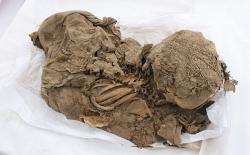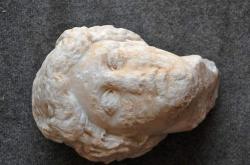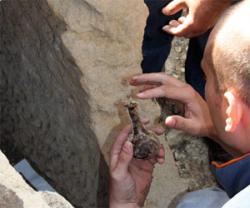INSTITUT SUPERIEUR D'ANTHROPOLOGIE
INSTITUTE OF ANTHROPOLOGY
ONLINE COURSES / COURS A DISTANCE
WINTER TERM : JANUARY 2014
REGISTER NOW
PEROU – 

 Lima - Archaeologists have uncovered remains of over 100 dogs thought to be 1,000 years old in the ancient ruins of Parque de las Leyendas in Lima, Peru. Sixty-two complete canine remains were found along with seventy-five incomplete remains according to Peru’s El Comercio. All the dog skeletons were found in resting positions alongside human remains. The dogs are thought to be companions to the humans they were buried with and part of a ritual ceremony. The remains were found in the Maranga Archaeological Complex located inside the Parque de las Leyendas. The park houses the city zoo and botanical gardens of Lima but are also home to one of the country’s most important pre-Hispanic complexes. The dogs found are not thought to be the native pre-Incan hairless dog breed (Perro Sin Pelo) but rather dogs that possessed yellowish/brown fur. Evolutionary geneticists concur that dogs have been on this earth since humans have been. In 2006 archaeologists unearthed forty mummified dogs in a 1,000 year-old pet cemetery south of the capital city. Many of the dogs had llama and fish bones next to their noses to make sure they had something to eat in the afterlife. In 2010 the remains of six canines and four children were found also thought to be 1,000 years old. These discoveries highlight the important status dogs had in ancient pre-Hispanic cultures
Lima - Archaeologists have uncovered remains of over 100 dogs thought to be 1,000 years old in the ancient ruins of Parque de las Leyendas in Lima, Peru. Sixty-two complete canine remains were found along with seventy-five incomplete remains according to Peru’s El Comercio. All the dog skeletons were found in resting positions alongside human remains. The dogs are thought to be companions to the humans they were buried with and part of a ritual ceremony. The remains were found in the Maranga Archaeological Complex located inside the Parque de las Leyendas. The park houses the city zoo and botanical gardens of Lima but are also home to one of the country’s most important pre-Hispanic complexes. The dogs found are not thought to be the native pre-Incan hairless dog breed (Perro Sin Pelo) but rather dogs that possessed yellowish/brown fur. Evolutionary geneticists concur that dogs have been on this earth since humans have been. In 2006 archaeologists unearthed forty mummified dogs in a 1,000 year-old pet cemetery south of the capital city. Many of the dogs had llama and fish bones next to their noses to make sure they had something to eat in the afterlife. In 2010 the remains of six canines and four children were found also thought to be 1,000 years old. These discoveries highlight the important status dogs had in ancient pre-Hispanic cultures
.http://www.hispanicallyspeakingnews.com/latino-daily-news/details/1000-year-old-dog-skeletons-found-in-lima-peru/27844/
ROYAUME UNI - Selkirk - The first excavation of Selkirk Castle hasn’t found much, but a gas board digger did blunder through a 16th-century wall into a tunnel earlier this week. Archaeologists and volunteers excavating the medieval motte and bailey atop the Haining’s woodlands have spent a week carefully hand-shifting tonnes of soil, for a handful of medieval artefacts. But it took a gas board JCB just minutes on Monday morning to strike, and then gouge through, a metre-thick historic wall, tunnel or stairway. Archaeologists excavating Selkirk Castle up the hill grew alarmed when they heard the digger, and Scottish Borders Council’s archaeology officer Dr Chris Bowles arrived quickly to suggest it stop.At first they believed the gas board had discovered foundations of the 16th-century, L-shaped Haining towerhouse, but now they believe it is servants’ steps to the basement, once the towerhouse’s ground floor.
http://www.selkirkweekendadvertiser.co.uk/news/local-news/jcb-beats-archaeologists-for-haining-dig-finds-1-3172674
ROYAUME UNI –  Chester Green - Archaeologists have begun digging in the hope of unearthing the corners of a Roman fort in Derby. A team of historians will be in Chester Green for two weeks following the discovery of a previously undiscovered Roman settlement earlier this year. And yesterday marked the first day of the dig. Paul Dunn, archaeologist and supervisor of the dig, said: "We're trying to get to the corners of the Roman fort. "We're hoping that somewhere here we have got a corner. "We're hoping to find the defensive ditches – a cut in the ground a bit like a drain – around the fort." Chester Green is well known as the site of a Roman fort. This most recent phase of the dig will investigate three new archeological trenches in the southern part of Darley Playing Field, where the Roman settlement was unearthed earlier this year. It is being carried out as part of the Our City Our River flood defence works in Chester Green. The first phase of the work unearthed important discoveries, including the remains of a Roman road with the foundations of Roman buildings on either side of it.
Chester Green - Archaeologists have begun digging in the hope of unearthing the corners of a Roman fort in Derby. A team of historians will be in Chester Green for two weeks following the discovery of a previously undiscovered Roman settlement earlier this year. And yesterday marked the first day of the dig. Paul Dunn, archaeologist and supervisor of the dig, said: "We're trying to get to the corners of the Roman fort. "We're hoping that somewhere here we have got a corner. "We're hoping to find the defensive ditches – a cut in the ground a bit like a drain – around the fort." Chester Green is well known as the site of a Roman fort. This most recent phase of the dig will investigate three new archeological trenches in the southern part of Darley Playing Field, where the Roman settlement was unearthed earlier this year. It is being carried out as part of the Our City Our River flood defence works in Chester Green. The first phase of the work unearthed important discoveries, including the remains of a Roman road with the foundations of Roman buildings on either side of it.
VIDEO = http://www.derbytelegraph.co.uk/VIDEO-Chester-Green-dig-aims-unearth-evidence/story-20033719-detail/story.html
CHINE – Wuyang - Archaeologists have unearthed three flutes made from the bones of red-crowned cranes in Henan province that dates back 8,000 years, according to Zhengzhou Evening News. One flute, which has five finger holes, is complete. The longest flute, at more than 20 centimeters long, has two holes but is broken into three pieces. The flutes indicate people in the Huaihe River Delta 8,000 years ago had an affinity for music. The recent discovery was made in a village in Wuyang county, which is 777 square kilometers. The village is located near the site of the Jiahu Ruins that was first discovered in 1961. The Jiahu Ruins date back 7,700 to 9,000 years. Carbonized rice grains, animal bones and tortoise shells have been unearthed at the site.
http://europe.chinadaily.com.cn/china/2013-11/01/content_17075368.htm
TURQUIE –  Antiochia ad Cragum- Years of exploring the mountains and fields of southern Turkey paid off over the summer when a University of Nebraska-Lincoln archaeological team made a lovely find. The team unearthed a life-size marble head of Aphrodite, the Greek goddess of love, desire and beauty. The team, led by Hixson-Lied professor of art history Michael Hoff, has been excavating the remains of the ancient city Antiochia ad Cragum, near the southern coast of Turkey. Last year Hoff’s team uncovered a mosaic thought to be the largest of its type in the region. The 1,600-square-foot mosaic depicted flowers and fruit and is believed to have been part of a Roman bathhouse. “The mosaic was stupendous, and the statue was an exclamation point,” Hoff said. Aphrodite’s head is the first example of a monumental statue found at the site. Hoff said mythological statues are common in Turkey but had not been uncovered yet in Antiochia ad Cragum because of limited excavation. “We find fragments and pieces that escape getting thrown into the kiln, and luckily we found this head,” Hoff said. Scarred with chips and cracks on its nose and face, the head of Aphrodite’s statue most likely avoided destruction during the Roman Byzantine period, about A.D. 330. Hoff said the area where the head was found was once used to destroy ancient marble statues, to get lime for making mortar or because they were considered pagan symbols. “Some rather zealous Christians were destroying images of Greek gods and goddesses to get rid of pagan images,” he said. As for the rest of Aphrodite’s body, Hoff said it was most likely incinerated. Before the excavation began in 2005, Hoff and his colleagues spent 10 years conducting a survey of the area. They based their decision to excavate Antiochia ad Cragum on historical context, accessibility and its potential to reveal new information. The ancient Mediterranean city once numbered perhaps 4,000 to 5,000 people, Hoff said.
Antiochia ad Cragum- Years of exploring the mountains and fields of southern Turkey paid off over the summer when a University of Nebraska-Lincoln archaeological team made a lovely find. The team unearthed a life-size marble head of Aphrodite, the Greek goddess of love, desire and beauty. The team, led by Hixson-Lied professor of art history Michael Hoff, has been excavating the remains of the ancient city Antiochia ad Cragum, near the southern coast of Turkey. Last year Hoff’s team uncovered a mosaic thought to be the largest of its type in the region. The 1,600-square-foot mosaic depicted flowers and fruit and is believed to have been part of a Roman bathhouse. “The mosaic was stupendous, and the statue was an exclamation point,” Hoff said. Aphrodite’s head is the first example of a monumental statue found at the site. Hoff said mythological statues are common in Turkey but had not been uncovered yet in Antiochia ad Cragum because of limited excavation. “We find fragments and pieces that escape getting thrown into the kiln, and luckily we found this head,” Hoff said. Scarred with chips and cracks on its nose and face, the head of Aphrodite’s statue most likely avoided destruction during the Roman Byzantine period, about A.D. 330. Hoff said the area where the head was found was once used to destroy ancient marble statues, to get lime for making mortar or because they were considered pagan symbols. “Some rather zealous Christians were destroying images of Greek gods and goddesses to get rid of pagan images,” he said. As for the rest of Aphrodite’s body, Hoff said it was most likely incinerated. Before the excavation began in 2005, Hoff and his colleagues spent 10 years conducting a survey of the area. They based their decision to excavate Antiochia ad Cragum on historical context, accessibility and its potential to reveal new information. The ancient Mediterranean city once numbered perhaps 4,000 to 5,000 people, Hoff said.
http://www.omaha.com/article/20131104/NEWS/131109507
BULGARIE –  Varna - The busy market place in the Bulgarian coastal town of Varna yielded another sarcophagus, the third to be found over the last two days by builders, working on a construction site nearby. Decking the sarcophagus, archaeologists found bronze coins, perfume vials, a lamp and a jar. The graveyard was unearthered for the first time at the end of last week in a region known as the Odessos necropolis. It was found to contain the skeletons of a 30-year-old woman and a man, who are believed to have been a poor family. An ancient coin was found, which is believed to have been put under the tongue of the dead man. He was to give the coin to ferryman Charon to transport his souls across the river Styx into the underworld. -
Varna - The busy market place in the Bulgarian coastal town of Varna yielded another sarcophagus, the third to be found over the last two days by builders, working on a construction site nearby. Decking the sarcophagus, archaeologists found bronze coins, perfume vials, a lamp and a jar. The graveyard was unearthered for the first time at the end of last week in a region known as the Odessos necropolis. It was found to contain the skeletons of a 30-year-old woman and a man, who are believed to have been a poor family. An ancient coin was found, which is believed to have been put under the tongue of the dead man. He was to give the coin to ferryman Charon to transport his souls across the river Styx into the underworld. -
http://www.novinite.com/view_news.php?id=86435#sthash.YPfmNTtW.dpuf
BULGARIE –  Varna - Builders, working on a construction site near the market place of the Bulgarian coastal town of Varna, unearthed a second century necropolis containing two sarcophagi. The graveyard was discovered in a region known as the Odessos necropolis and contained the skeletons of a 30-year-old woman and a man, who are believed to have been a poor family. An ancient coin was found, which is believed to have been put under the tongue of the dead man. He was to give the coin to ferryman Charon to transport his souls across the river Styx into the underworld. -
Varna - Builders, working on a construction site near the market place of the Bulgarian coastal town of Varna, unearthed a second century necropolis containing two sarcophagi. The graveyard was discovered in a region known as the Odessos necropolis and contained the skeletons of a 30-year-old woman and a man, who are believed to have been a poor family. An ancient coin was found, which is believed to have been put under the tongue of the dead man. He was to give the coin to ferryman Charon to transport his souls across the river Styx into the underworld. -
http://www.novinite.com/view_news.php?id=86380